Long term FreeBSD user, embedded systems work. Most recent server, a Sun X3-2, a single i5
machine, running for over year with 12.3 release. New server to be a 2u DL380 G8, to gain more
pcie slots.
Have a generic rc.conf that is edited, ip and hostname etc, on each new machine. More or less
standardised on amd V3900 on all machines. Don't need fancy graphics, just reasonable 2d
desktop performance and the v3900 is cheap and good on power at around 10 watts.
All the usual packages installed: xorg, xfce4, slim, drm-kmod. Also installed the old xf86-video-ati,
but makes no difference.
On reboot, system panic at the kld load stage in rc.conf. Commented out, everything normal,
but a kldload from the command line also panics. Tried various things.
* Package update, but tells me everything is up to date
* Deinstall amd packages and reinstall, even tried rebuilding from ports.
* All the amd files do seem to be in place in /usr/boot/modules
Include a screenshot of the panic. Takes a power cycle to recover.
Running out of ideas. All usually works out of the box with no issues, so what am I missing here ?...

machine, running for over year with 12.3 release. New server to be a 2u DL380 G8, to gain more
pcie slots.
Have a generic rc.conf that is edited, ip and hostname etc, on each new machine. More or less
standardised on amd V3900 on all machines. Don't need fancy graphics, just reasonable 2d
desktop performance and the v3900 is cheap and good on power at around 10 watts.
All the usual packages installed: xorg, xfce4, slim, drm-kmod. Also installed the old xf86-video-ati,
but makes no difference.
On reboot, system panic at the kld load stage in rc.conf. Commented out, everything normal,
but a kldload from the command line also panics. Tried various things.
* Package update, but tells me everything is up to date
* Deinstall amd packages and reinstall, even tried rebuilding from ports.
* All the amd files do seem to be in place in /usr/boot/modules
Include a screenshot of the panic. Takes a power cycle to recover.
Running out of ideas. All usually works out of the box with no issues, so what am I missing here ?...


